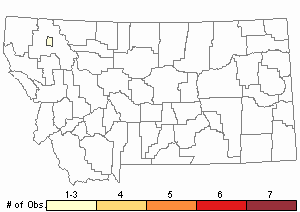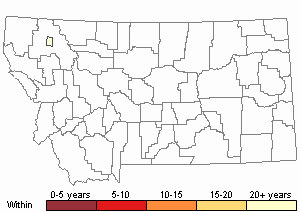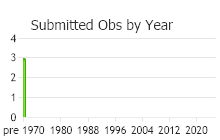View in other NatureServe Network Field Guides
NatureServe
Montana
Utah
Wyoming
Idaho
Wisconsin
British Columbia
South Carolina
Yukon
California
New York
A Nodding Moss - Pohlia atropurpurea
General Description
Plants: Acrocarpous, the plants tiny (FNA 2014), growing in open, upright clumps (Crum and Anderson et al. 1981) or more dispersed, green, reddish-green (Lawton 1971) or more reddish, glossy. Stems 2-4 mm tall (FNA 2014), seldom forked; rhizoids several, with papillae absent (Lawton 1971).
Leaves: Loosely upright, spreading about 45 degrees or more when damp (FNA 2014), similar when dry (Lawton 1971), lance-shaped, narrowing to an acute leaf tip; leaf edges flat (FNA 2014) in lower leaves, often slightly curved back and downward in the upper stem leaves (Lawton 1971), in the apical region faintly and finely saw-toothed (FNA 2014); base not decurrent (Lawton 1971); costa terminating well below the leaf tip (FNA 2014), red (Lawton 1971).
Leaf Cells: Upper medial laminal cells flaccid and widely diamond-shaped with fine walls (FNA 2014).
Phenology
Fruit ripens in spring (FNA 2014).
Range Comments
North American Range
AK and YT s to WA and ID, also CA, MB, ON and NL, MN, IA, and NY (FNA 2014). Known in Montana from Flathead County (Elliott and Pipp 2016).
Observations in Montana Natural Heritage Program Database
Number of Observations: 3
(Click on the following maps and charts to see full sized version)
Map Help and Descriptions
Relative Density

Recency


 (Observations spanning multiple months or years are excluded from time charts)
(Observations spanning multiple months or years are excluded from time charts)
Habitat
Damp (Lawton 1971), finely-particled soil, seldom sandy, on banks of trails and watercourses (FNA 2014). Occurring from low elevations to about 3280 feet (Lawton 1971).
Reproductive Characteristics
Dioicous. Perichaetial bracts closely resembling stem leaves (FNA 2014). Seta 5-10 mm tall (Lawton 1971), solitary, brown tinged with orange. Capsule carried well-beyond the perichaetial bracts, russet to straw-colored, drooping vertically or nearly so, short and shaped like a pear or urn (FNA 2014) or, when dry and following dehiscence, nearly hemispherical, the opening wide, the neck short and somewhat obscure (Lawton 1971); stomata occurring on the capsule’s surface (FNA 2014) or slightly sunken (Lawton 1971), located in the neck region (Crum and Anderson et al. 1981); exostome teeth deltoid with a narrow tip, russet to deep brown, pitted below (FNA 2014), finely and thickly papillose (Crum and Anderson et al. 1981); endostome processes keeled, with wide openings, papillae, and long, knobby cilia (FNA 2014).
References
- Literature Cited AboveLegend:
 View Online Publication
View Online Publication Crum, H.A. and L.E. Anderson. 1981. Mosses of Eastern North America. 2 volumes. Columbia University Press, New York. 1328 pp.
Crum, H.A. and L.E. Anderson. 1981. Mosses of Eastern North America. 2 volumes. Columbia University Press, New York. 1328 pp. Elliott, J.C. and A.K. Pipp. 2018. A Checklist of Montana Mosses (1880-2018). Updated 3 January, 2020. Montana Natural Heritage Program, Helena, Montana. 73 pp.
Elliott, J.C. and A.K. Pipp. 2018. A Checklist of Montana Mosses (1880-2018). Updated 3 January, 2020. Montana Natural Heritage Program, Helena, Montana. 73 pp. Flora of North America Editorial Committee, eds. 2014. Flora of North America North of Mexico. Volume 28. Bryophytes: Mosses, Part 2. Oxford University Press, Inc., NY. xxi + 702 pp.
Flora of North America Editorial Committee, eds. 2014. Flora of North America North of Mexico. Volume 28. Bryophytes: Mosses, Part 2. Oxford University Press, Inc., NY. xxi + 702 pp. Lawton, E. 1971. Moss Flora of the Pacific Northwest. Hattori Botanical Laboratory. Japan: Yamabuki-cho, Shinjuku-ku, Tokyo. 362 pages plus appendices.
Lawton, E. 1971. Moss Flora of the Pacific Northwest. Hattori Botanical Laboratory. Japan: Yamabuki-cho, Shinjuku-ku, Tokyo. 362 pages plus appendices.
- Additional ReferencesLegend:
 View Online Publication
View Online Publication
Do you know of a citation we're missing? Elliot, J. C. 1993. Second checklist of Montana mosses. Unpublished report. U.S. Forest Service, Region 1. Missoula, MT. 45 pp.
Elliot, J. C. 1993. Second checklist of Montana mosses. Unpublished report. U.S. Forest Service, Region 1. Missoula, MT. 45 pp. Lawton, E. 1971. Keys for the Identification of the Mosses on the Pacific Northwest. Reprinted from 'Moss Flora of the Pacific Northwest'. Published as Supplement No. 2 of the Journal of the Hattori Botanical Laboratory. Nichinan, Miyazaki, Japan. 66 pp.
Lawton, E. 1971. Keys for the Identification of the Mosses on the Pacific Northwest. Reprinted from 'Moss Flora of the Pacific Northwest'. Published as Supplement No. 2 of the Journal of the Hattori Botanical Laboratory. Nichinan, Miyazaki, Japan. 66 pp.
- Web Search Engines for Articles on "A Nodding Moss"





